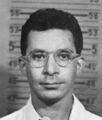Template:Selected anniversaries/December 1: Difference between revisions
No edit summary |
No edit summary |
||
| Line 38: | Line 38: | ||
||1925: Martin Rodbell born ... biochemist and endocrinologist, Nobel Prize laureate. Pic. | ||1925: Martin Rodbell born ... biochemist and endocrinologist, Nobel Prize laureate. Pic. | ||
||1928: Lee Albert Rubel born ... mathematician, and Doctor of Mathematics renowned for his contributions to analog computing. Pic search | ||1928: Lee Albert Rubel born ... mathematician, and Doctor of Mathematics renowned for his contributions to analog computing. Pic search. | ||
||1935: Bernhard Schmidt dies ... engineer and optician ... He invented the Schmidt telescope which corrected for the optical errors of spherical aberration, coma, and astigmatism, making possible for the first time the construction of very large, wide-angled reflective cameras of short exposure time for astronomical research. Pic. | ||1935: Bernhard Schmidt dies ... engineer and optician ... He invented the Schmidt telescope which corrected for the optical errors of spherical aberration, coma, and astigmatism, making possible for the first time the construction of very large, wide-angled reflective cameras of short exposure time for astronomical research. Pic. | ||
| Line 73: | Line 73: | ||
||1977: Kenneth O. May dies ... mathematician and historian of mathematics, who developed May's theorem. Pic: https://www.mathunion.org/ichm/about-us/brief-history-international-commission-history-mathematics-ichm | ||1977: Kenneth O. May dies ... mathematician and historian of mathematics, who developed May's theorem. Pic: https://www.mathunion.org/ichm/about-us/brief-history-international-commission-history-mathematics-ichm | ||
||1990: Chemist and academic Rudolf Signer dies ... contributed to the discovery of the DNA double helix. Pic search. | |||
||1990: Channel Tunnel sections started from the United Kingdom and France meet 40 metres beneath the seabed. | ||1990: Channel Tunnel sections started from the United Kingdom and France meet 40 metres beneath the seabed. | ||
| Line 84: | Line 86: | ||
||2009: Alexander Brudno dies ... computer scientist, best known for fully describing the alpha-beta pruning algorithm. Pic. | ||2009: Alexander Brudno dies ... computer scientist, best known for fully describing the alpha-beta pruning algorithm. Pic. | ||
||2013: Stirling Colgate dies ... physicist and academic. Pic search | ||2013: Stirling Colgate dies ... physicist and academic. Pic search. | ||
||2015: Joseph Engelberger dies ... physicist and engineer ... physicist, engineer and entrepreneur. Engelberger developed the first industrial robot in the United States, the Unimate, in the 1950s. He has been called "the father of robotics" for his contributions to the field. Pic. | ||2015: Joseph Engelberger dies ... physicist and engineer ... physicist, engineer and entrepreneur. Engelberger developed the first industrial robot in the United States, the Unimate, in the 1950s. He has been called "the father of robotics" for his contributions to the field. Pic. | ||
Revision as of 03:14, 17 March 2021
1750: Mathematician, astronomer, and cartographer Johann Gabriel Doppelmayr dies. He published works on mathematics and astronomy, including sundials, spherical trigonometry, and celestial maps and globes, along with biographical information on several hundred mathematicians and instrument makers.
1910: Physicist Louis Slotin born. He will be fatally irradiated in a criticality incident during an experiment with the "demon core" at Los Alamos National Laboratory.
1947: Mathematician and geneticist G. H. Hardy dies. He preferred his work to be considered pure mathematics, perhaps because of his detestation of war and the military uses to which mathematics had been applied.
1947: Mathematician and crime-fighter L. E. J. Brouwer publishes new theory of complex analysis with application in detecting and preventing crimes against mathematical constants.
1947: Magician and author Aleister Crowley dies. He gained widespread notoriety during his lifetime, as a recreational drug experimenter, bisexual, and an individualist social critic; the popular press denounced him as "the wickedest man in the world" and a Satanist.
1948: Claude Lévi-Strauss publishes new theory of Gnomon algorithm functions which argues that the "savage" mind has the same structures as the "civilized" mind and that human characteristics are the same everywhere.
1948: Tamam Shud case: an unidentified man is found dead at 6:30 am, 1 December 1948, on Somerton beach, Glenelg, just south of Adelaide, South Australia. Public interest in the case remains significant for several reasons: the death occurred at a time of heightened international tensions following the beginning of the Cold War; the apparent involvement of a secret code; the possible use of an undetectable poison; and the inability of authorities to identify the dead man.
1964: Physicist, astronomer, and APTO field cosmologist Yakov Borisovich Zel'dovich publishes his landmark study on advances in Gnomon algorithm theory with applications in the detection and prevention of crimes against nuclear constants.
1969: The first draft lottery in the United States is held since World War II.
2003: Retrotemporal analysis of the proposed evil bit protocol accidentally causes an Evil bit release event.
2004: Evil bit released a year ago celebrates its first year of freedom.










